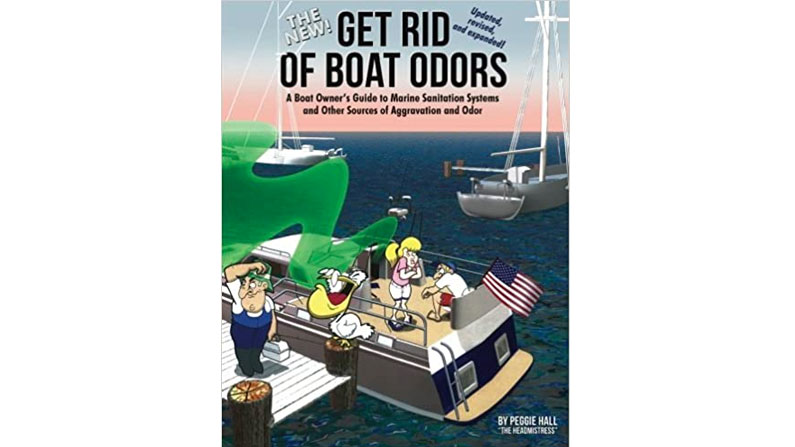 This book could be called the “Bible of Bile” or perhaps “Fifty Shades of Gray and Black Water” but its real title is longer than your boat’s sanitation hose. It is The New! Updated, revised and expanded! Get Rid of Boat Odors: A Boat Owner’s Guide to Marine Sanitation Systems and Other Sources of Aggravation and Odor.
This book could be called the “Bible of Bile” or perhaps “Fifty Shades of Gray and Black Water” but its real title is longer than your boat’s sanitation hose. It is The New! Updated, revised and expanded! Get Rid of Boat Odors: A Boat Owner’s Guide to Marine Sanitation Systems and Other Sources of Aggravation and Odor.
Author Peggy Hall is respectfully known as “The Headmistress” in boating circles and her 2006 edition of this book proved quite popular, but if one judged this 116-page book solely by its lengthy and somewhat misleading title, or its amateurish and silly cover, it would not pass the smell test. Thirty-three pages, or about one-quarter of the book, are exploded diagrams of the detailed components of marine heads and pumps. While some are clearly illustrated and labeled, others are too small or otherwise poorly reproduced. A one-page manufacturer-supplied guide about troubleshooting requires a magnifying glass to decipher. If you own a marine sanitation device, or MSD, you probably have a manual (or can obtain one) with the one diagram you need, or find it online.
Generally speaking, most boat owners will likely not take an entire toilet or pump apart or need a complete diagram, but will need to know about purchasing and using rebuild kits. Oddly, only two pages are specifically devoted to rebuilding, following a helpful discussion of the crucial “joker valves.”
Yet the helpful and authoritative information in this book may not likely be found elsewhere. The Headmistress explains federal laws and regulations and the differences between the different types of marine heads and how they work so the reader can choose and install a head or tank and maintain and use them properly. For example, you might be surprised to learn that one can legally urinate or defecate directly into the water but onecannot legally dump directly from a bucket (bucket and chuck-it). Hall admonishes readers to perform proper maintenance, from lubrication to cleaning the tank and line, to replacing seals and proper pumping methods.
According to the author, this new edition is substantially upgraded and updated from the first 90-page edition. Hall is best with helpful hints and basic information but there are only four pages dealing with odors other than from the sanitation system. I wish there were more about enclosed spaces and ventilation, moisture detection and abatement, mildew, food storage, proper chemicals, etc. For example, while restoring my boat, I made extensive use of a pressure steam cleaner, which has helped a lot, so perhaps Hall could have discussed steam cleaning and other methods to get rid of odors.
Hall clearly knows more about MSDs than most of us ever cared to know, and it is important to focus attention there as much as we focus attention on other boating equipment. I only wish the book would have either dispensed with, or perhaps improved, the 33 pages of exploded diaphragms, er I mean diagrams, and expanded more on actual troubleshooting, repairs, sources, and solutions to other odor sources. Further cleaning and lubrication of the words and layouts would have made this helpful book even more pleasant and fresh but I can still recommend it for what it does have and does well. Now, go examine your head!
Get Rid Of Boat Odors: A Boat Owner’s Guide To Marine Sanitation Systems And Other Sources Of Aggravation And Odor by Peggie Hall (Seaworthy Publications, Inc., 2016, 114 pages)





